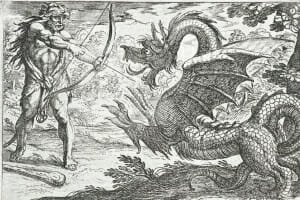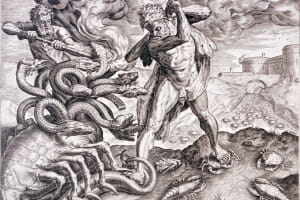Ladon Greek Mythology: The Myth of the Multi-Headed Hesperian Dragon
 Ladon Greek mythology follows the legend of the Hesperian Dragon who was tasked by the Hesperides, the daughters of Atlas, to guard the golden apples. Ladon was up to the task as his fearsome appearance was enough to scare the bravest of men from stealing the apples. No one could sneak in on him for his hundred heads could see all around him and no one could kill him except one man. Keep reading to discover this man and how he managed to kill the 100-headed beast.
Ladon Greek mythology follows the legend of the Hesperian Dragon who was tasked by the Hesperides, the daughters of Atlas, to guard the golden apples. Ladon was up to the task as his fearsome appearance was enough to scare the bravest of men from stealing the apples. No one could sneak in on him for his hundred heads could see all around him and no one could kill him except one man. Keep reading to discover this man and how he managed to kill the 100-headed beast.
The Myth of Ladon
Ladon’s Origin
Several versions of the myth mention different people like the parents of the Hesperian dragon. According to one version, he was the son of the primordial sea deities Phorcys and Ceto. Another version mentions the serpentine giant Typhon as his father and the monster Echidna as his mother. Other narrations mention Gaia or Hera as giving birth to Ladon without the intervention of a male.
According to the poet Ptolemy Hephaestion, Ladon was the brother of the dangerous beast, the Nemean lion.
Hera Appoints Ladon to Guard the Her Gold-Colored Apples
Hera, the Queen of the gods, had a garden in the west at the edges of Oceanus, the river that circled the world. Though the garden had lots of treasure, it had only one tree which produced gleaming apples and was tended by the Hesperides.
The apples were given to her as a wedding gift by the primordial sea goddess, Gaia. The apples granted immortality to whoever ate them, therefore competition for them was quite keen and the Hesperides, also known as nymphs of the evening, often took some of the apples for themselves.
Hera noticed what the Hesperides were doing and decided that she needed additional security to keep the fruits safe. Thus, she appointed Ladon, her son, to guard the apples and to keep an eye on the Hesperides. This, he did perfectly by warding off anyone that attempted to gain immortality by stealing the apples.
Description of Ladon
Originally, Ladon was thought of as a serpentine creature that wrapped its body around the apple tree. However, the Greek poet Aristophanes depicted Ladon as a beast with several heads and eventually, people began picturing Ladon as a monster with 100 heads. Eventually, he became known as Ladon the 100-Headed Dragon who never got weary nor slept on duty.
Ladon was believed to have 100 voices or he had the ability to mimic voices. Due to his 100 heads, he could see every direction at the same time. According to the myth, the various Ladon heads of Ladon took turns sleeping while the others kept awake. With his several heads, Ladon tormented the Titan Atlas by constantly biting him but he never died.
Ladon Vs Hydra
It is easy to confuse Ladon with Hydra, a serpentine beast who lived in the waters of Lerna in the Argolid region. Just like Ladon, Hydra’s parents were Typhon and Echidna, according to the Greek poet Hesiod.
However, where they differ is in their physical descriptions and their roles. Ladon had 100 heads compared to the nine heads of Hydra and whenever one of Hydra’s heads was cut off, two quickly grew back. The same is said of Ladon who also has quick regeneration after he was injured.
Hydra was serpentine while Ladon was more dragon-like with a set of wings and a skin similar to plant material. Additionally, Ladon Greek mythology powers were limited when compared to Hydra’s strengths.
For instance, the breath of Hydra was poisonous and its blood was so toxic that anyone who smelled it died. When one ingested Hydra’s poison, they exploded because the venom caused its victim’s blood cells to multiply at breakneck speed.
Ladon, on the other hand, turned victims into plants with a kiss. According to ancient myths, because Ladon was bigger than the Hydra, it killed and fed on it. Hydra was found in swampy areas while Ladon was employed to guard great treasures.
Both creatures were killed by Hercules as part of the twelve tasks assigned to him by Eurystheus. Finally, when it came to intelligence, the Ladon carried the day due to its ability to speak several languages.
Ladon and Heracles
As mentioned in the previous paragraph, Hercules was given the task of killing Ladon as part of his Twelve Labors. As common with myths from ancient Greek, there are various versions of Heracles laying his hands on the apples. One version states that Heracles journeyed to the far west, through the Libya desert, looking for the elusive garden of Hera. He met Nereus, the son of Gaia and Pontus, who was a shapeshifter and kept eluding Heracles until he was caught.
Nereus then told Heracles that he could only find the garden if he met Prometheus, the Titan deity of fire. Nereus told him where to find Prometheus and Heracles continued his journey.
Prometheus at the time had offended the gods by stealing their fire so they punished him by chaining him to a rock and instructing an eagle to eat his liver. Heracles eventually located Prometheus and he shot an arrow at the eagle killing it instantly.
Prometheus, happy that he had been freed, thanked Heracles and told him that his (Prometheus’) brother, Atlas, knew the location of the garden. Atlas showed him where the garden of the Hesperides was and Hercules went his way. On reaching the orchard, Hercules shot a poisonous arrow at Ladon which killed him. He then took the apples and ran off, completing the task assigned to him by Eurystheus.
Ladon and Atlas
According to another version of the myth, Heracles, after locating Atlas, tricked him into getting the apples. Zeus had punished Atlas for taking part in the war against the Olympian gods by asking him to hold the heavens up. When Heracles found Atlas, Atlas told him to help hold the heavens up while he went to fetch the apples for Heracles. Since Atlas was the father of the Hesperides, he was able to get the apples from the tree without any fuss.
However, when he came back with the apples he refused to take the heavens from Heracles and that was where Heracles used his trickery. Heracles told Atlas that he would love to continue holding the sky up but he’d first need to adjust his cloak. Thus, he gave the heavens to Atlas to hold and when Atlas took up the heavens, Heracles ran off as quickly as his legs could carry him with the apples. In this version of the myth, Heracles did not encounter Ladon but he got the apples anyway.
Ladon in Astronomy
In the book Astronomy by the Latin author Gaius Hyginus, the constellation in the far northern sky is called Draco, after Ladon. According to the myth, Zeus placed him among the stars, probably after Heracles killed him in the garden of the Hesperides. The Roman astronomer, Ptolemy, included Draco in his 48 constellations and it is still part of today’s 88 constellations. Astronomers can see the constellation all year round from northern latitudes.
Other Versions of Ladon
Many scholars believe that the Greek Ladon was inspired by Lotan, another monster from the Amorite tradition. Lotan was also thought to be preceded by Temtum, a serpent depicted in Syrian seals from between the 18th-16th centuries BC. Lotan also influenced the Leviathan which is found in the Hebrew Bible.
Another figure from which the Greeks probably formed Ladon was Illuyanka, a serpentine dragon who initially fought with the storm god, Tarhunz, and won. However, Illuyanka was later killed by Tarhunz on the advice of Inara’s, the goddess of wild animals.
The Pronunciation of Ladon
The name is pronounced |Lah-dun|.
Ladon Percy Jackson
Ladon is featured in the Rick Riordan book series, Percy Jackson and the Olympians, in his original role as the guardian of the gleaming apples in the garden of the Hesperides. Ladon aids in the death of Zoe Nightshade by injecting poison into her bloodstream through a bite.
Conclusion
This article has looked at the origins and mythology of the ancient Greek serpent, Ladon. Here is a recap of all that we’ve discovered about the serpentine beast so far:
- Ladon was either the son of the primordial sea deities Ceto and Phocis, Typhon and Echidna, or was birthed by either Gaia or Hera without any male involvement.
- Hera, the Queen of the gods, tasked him to guard her bright apples in the garden because she did not trust her maidens, the Hesperides, to do a great job.
- Ladon had 100 heads that looked in every direction, making it difficult for anyone to steal the apples for when one head slept, the other 99 were wide awake.
- However, the beast was killed with a poisoned arrow by Heracles as part of the Twelve Labors assigned to him by King Eurystheus of Mycenae.
- After his death, he was transformed into a constellation in the sky known today as Draco.
The figure of Ladon was inspired either by Lotan from Ugaritic texts or Illuyanka from the Hittites myths. Ladon makes an appearance in some modern literary works including Rick Riordan’s book, Percy Jackson and the Olympians.


